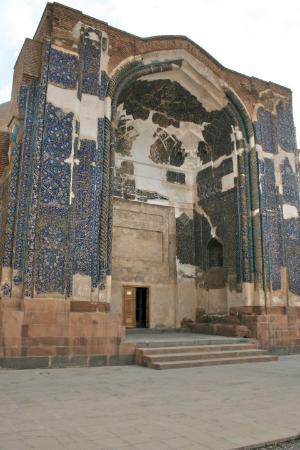 Blue Mosque
Blue Mosque
This mosque is one of the precious works of Islamic period (the Temurids) and is known as turquoise of Islam as it has been built of turquoise-colored bricks. It is one of the most beautiful buildings of Timurid period. Geographically, it has been located in a cold climatic condition, and for the same reason, it has no quadrangle. The remainder consists of a tomb and a mosque that its dome is double layered (unesco.org).
When it was constructed in 1465, the Mosque was among the most glorious buildings of its era. Once built, artists took a further 25 years to cover every surface with the blue majolica tiles and intricate calligraphy for which it’s nicknamed. It survived one of history’s worst-ever earthquakes (1727), but collapsed in a later quake (1773). Devastated Tabriz had better things to do than mend it and it lay as a pile of rubble till 1951, when reconstruction finally started. The brick superstructure is now complete, but only on the rear (main) entrance portal (which survived 1773) is there any hint of the original blue exterior. Inside is also blue with missing patterns laboriously painted onto many lower sections around the few remaining patches of original tiles.
A smaller domed chamber further from the entrance once served as a private mosque for the Qareh Koyunlu shahs. Steps lead down towards Jahan Shah’s tomb chamber but access would require some minor gymnastics (lonelyplanet.com).
The Blue Mosque in Tabriz has been built about 550 years ago. The most outstanding feature of this Mosque is its special blue tiles in Northern facade. The second most important feather is the large dome that spans a large area of about 30 m by 30 m. The other special structural feature is double layered roofing made up of bricks and some special hydraulic mortar.
The entrance portal with its two minarets appears to have been connected with the main prayer hall (Shabestan) under the largest cupola of the mosque, by means of vaulted corridor.
On both sides along the corridor, there stand the remains of the chambers with vaulted roofs. The walls of the mosque have been riveted with marble slabs and decorated with superb mosaic tiles. Some of the blue mosaics in the mosque's portal are heavily damaged and half missing. The mosque is now almost permanently closed, but renovation work and eventual reopening seem inevitable.